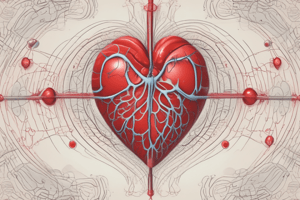Podcast
Questions and Answers
Which condition is characterized by the heart's inability to pump sufficient blood effectively?
Which condition is characterized by the heart's inability to pump sufficient blood effectively?
- Heart Failure (correct)
- Arrhythmia
- Coronary Artery Disease
- Peripheral Artery Disease
What type of cardiovascular disease is primarily caused by the buildup of plaque in coronary arteries?
What type of cardiovascular disease is primarily caused by the buildup of plaque in coronary arteries?
- Stroke
- Heart Failure
- Coronary Artery Disease (correct)
- Arrhythmias
Which of the following symptoms is NOT commonly associated with cardiovascular diseases?
Which of the following symptoms is NOT commonly associated with cardiovascular diseases?
- Swelling in legs
- Severe headaches (correct)
- Chest pain
- Shortness of breath
What risk factor for cardiovascular diseases is considered non-modifiable?
What risk factor for cardiovascular diseases is considered non-modifiable?
Which diagnostic test evaluates the electrical activity of the heart?
Which diagnostic test evaluates the electrical activity of the heart?
Which of the following treatments is categorized as a lifestyle change to reduce cardiovascular disease risk?
Which of the following treatments is categorized as a lifestyle change to reduce cardiovascular disease risk?
What is the main cause of ischemic stroke?
What is the main cause of ischemic stroke?
Which cardiovascular disease is characterized by abnormal heart rhythms?
Which cardiovascular disease is characterized by abnormal heart rhythms?
Flashcards are hidden until you start studying
Study Notes
Overview of Cardiovascular Diseases (CVD)
- Definition: A group of disorders affecting the heart and blood vessels.
- Prevalence: Leading cause of death globally.
Types of Cardiovascular Diseases
-
Coronary Artery Disease (CAD)
- Caused by plaque buildup in coronary arteries.
- Leads to heart attacks and angina.
-
Heart Failure
- Heart's inability to pump sufficient blood.
- Symptoms include fatigue, shortness of breath, and swelling.
-
Arrhythmias
- Abnormal heart rhythms (e.g., atrial fibrillation).
- Can lead to stroke or heart failure.
-
Peripheral Artery Disease (PAD)
- Narrowing of peripheral arteries, often in legs.
- Leads to pain and mobility issues.
-
Stroke
- Disruption of blood flow to the brain.
- Types: Ischemic (blockage) and Hemorrhagic (bleeding).
-
Congenital Heart Defects
- Structural problems present at birth.
- Vary in severity and impact on health.
Risk Factors
-
Modifiable
- Unhealthy diet (high in saturated fats and sugars)
- Physical inactivity
- Tobacco use
- Excessive alcohol consumption
- Obesity
-
Non-modifiable
- Age (risk increases with age)
- Gender (higher risk in men)
- Family history of CVD
- Genetic predisposition
Symptoms
- Chest pain or discomfort
- Shortness of breath
- Fatigue
- Heart palpitations
- Swelling in legs, abdomen, or feet
Diagnosis
- Physical Examination: Check for symptoms and risk factors.
- Tests:
- Electrocardiogram (ECG)
- Echocardiogram
- Stress tests
- Blood tests (cholesterol levels, blood glucose)
Prevention Strategies
- Adopt a heart-healthy diet (fruits, vegetables, whole grains).
- Regular physical activity (at least 150 minutes per week).
- Maintain a healthy weight.
- Avoid tobacco products.
- Manage stress effectively.
- Regular health screenings (monitor blood pressure, cholesterol).
Treatment Options
- Lifestyle Changes: Diet, exercise, smoking cessation.
- Medications: Statins, beta-blockers, anticoagulants.
- Procedures: Angioplasty, stent placement, bypass surgery.
- Cardiac Rehabilitation: Structured program to improve heart health post-diagnosis.
Conclusion
Understanding cardiovascular diseases is essential for prevention, early detection, and effective management, which can significantly reduce health risks and improve quality of life.
Overview of Cardiovascular Diseases (CVD)
- Group of disorders affecting the heart and blood vessels.
- Primary global cause of death.
Types of Cardiovascular Diseases
- Coronary Artery Disease (CAD): Plaque buildup in coronary arteries, leading to heart attacks and angina.
- Heart Failure: Inability of the heart to pump sufficient blood; symptoms include fatigue, shortness of breath, and swelling.
- Arrhythmias: Abnormal heart rhythms, such as atrial fibrillation; may result in stroke or heart failure.
- Peripheral Artery Disease (PAD): Narrowing of arteries in the legs; causes pain and mobility issues.
- Stroke: Disruption of blood flow to the brain; includes ischemic (blockage) and hemorrhagic (bleeding) types.
- Congenital Heart Defects: Structural heart problems present at birth with varying severity.
Risk Factors
- Modifiable:
- Unhealthy diet high in saturated fats and sugars.
- Physical inactivity.
- Tobacco usage.
- Excessive alcohol consumption.
- Obesity.
- Non-modifiable:
- Age, with increased risk as one gets older.
- Gender, with men at higher risk.
- Family history of CVD.
- Genetic predisposition.
Symptoms
- Chest pain or discomfort.
- Shortness of breath.
- Fatigue and heart palpitations.
- Swelling in the legs, abdomen, or feet.
Diagnosis
- Physical Examination: Evaluation of symptoms and risk factors.
- Tests:
- Electrocardiogram (ECG) to measure heart activity.
- Echocardiogram for structural assessment.
- Stress tests to evaluate heart function under exertion.
- Blood tests to check cholesterol levels and blood glucose.
Prevention Strategies
- Embrace a heart-healthy diet rich in fruits, vegetables, and whole grains.
- Engage in regular physical activity (minimum of 150 minutes weekly).
- Maintain a healthy weight.
- Avoid tobacco use and manage stress effectively.
- Participate in regular health screenings to monitor blood pressure and cholesterol levels.
Treatment Options
- Lifestyle Changes: Encourage diet modifications, regular exercise, and smoking cessation.
- Medications: Prescribe statins, beta-blockers, and anticoagulants.
- Procedures: Implement angioplasty, stent placement, or bypass surgery as necessary.
- Cardiac Rehabilitation: Join structured programs designed to improve heart health after diagnosis.
Conclusion
Mastering knowledge on cardiovascular diseases enhances prevention, early detection, and effective management, significantly minimizing health risks and elevating quality of life.
Studying That Suits You
Use AI to generate personalized quizzes and flashcards to suit your learning preferences.




